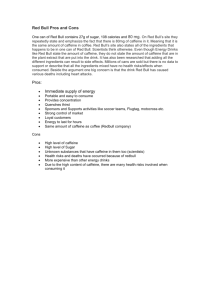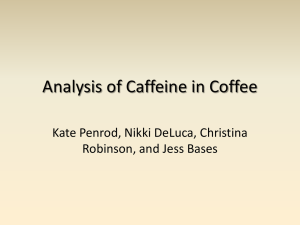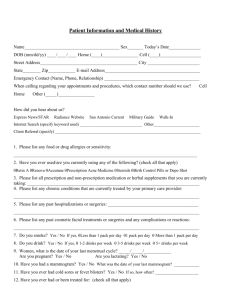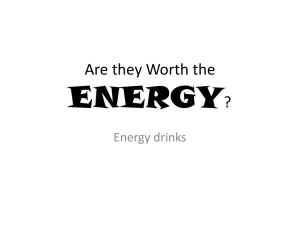Adolescent Consumption of Caffeinated Energy Drinks
advertisement
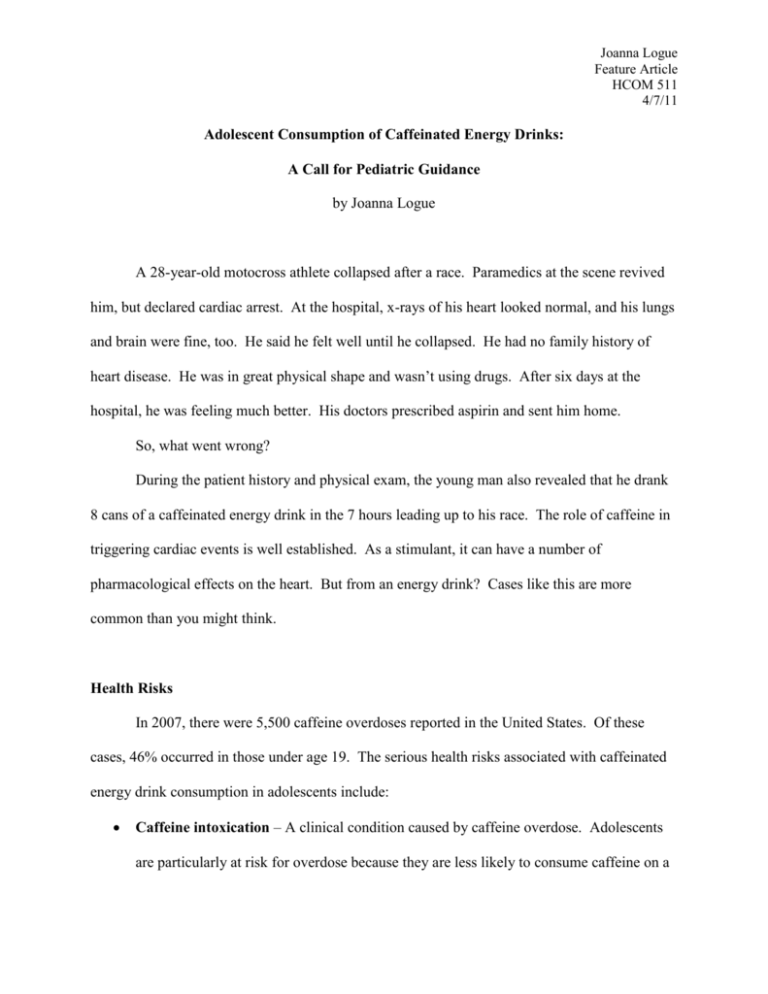
Joanna Logue Feature Article HCOM 511 4/7/11 Adolescent Consumption of Caffeinated Energy Drinks: A Call for Pediatric Guidance by Joanna Logue A 28-year-old motocross athlete collapsed after a race. Paramedics at the scene revived him, but declared cardiac arrest. At the hospital, x-rays of his heart looked normal, and his lungs and brain were fine, too. He said he felt well until he collapsed. He had no family history of heart disease. He was in great physical shape and wasn’t using drugs. After six days at the hospital, he was feeling much better. His doctors prescribed aspirin and sent him home. So, what went wrong? During the patient history and physical exam, the young man also revealed that he drank 8 cans of a caffeinated energy drink in the 7 hours leading up to his race. The role of caffeine in triggering cardiac events is well established. As a stimulant, it can have a number of pharmacological effects on the heart. But from an energy drink? Cases like this are more common than you might think. Health Risks In 2007, there were 5,500 caffeine overdoses reported in the United States. Of these cases, 46% occurred in those under age 19. The serious health risks associated with caffeinated energy drink consumption in adolescents include: Caffeine intoxication – A clinical condition caused by caffeine overdose. Adolescents are particularly at risk for overdose because they are less likely to consume caffeine on a Joanna Logue Feature Article HCOM 511 4/7/11 regular basis, and so have a lower tolerance level. Symptoms include anxiety, nausea, chest pain, insomnia, seizures, and hallucinations. Synergistic effects of caffeine and taurine – Many caffeinated energy drinks contain taurine. When combined with caffeine, this stimulant significantly increases heart rate and blood pressure. Caffeine dependence and withdrawal – Adolescents are particularly at risk because of marketing campaigns promoting caffeinated energy drink use among this group. Caffeine dependence can cause excess caffeine consumption and an inability to quit. An increase in dependence creates an increased risk for caffeine withdrawal, especially among adolescents who are more sensitive to the effects of caffeine. Combined effects of caffeinated energy drinks and alcohol – When mixing energy drinks with alcohol, users often don’t feel the effects of alcohol intoxication. This can lead to alcohol poisoning, alcohol-related injury, and increased chance of sexual violation. Still, energy drinks are the fastest growing beverage market in the United States. Studies show that 31% of 12- to 17-year-olds drink them regularly. So, given the health risks, why the popularity? Marketed Benefits Not only are adolescents most at risk for the harmful health effects of caffeinated energy drinks, but they are also most vulnerable to the associated marketing campaigns. Manufacturers promote these beverages claiming they provide energy and vitality. The advertised benefits include increased attention and better athletic and academic performance. Those who drink them Joanna Logue Feature Article HCOM 511 4/7/11 are promised to “have fun and kick butt.” Product media placement is specifically geared toward adolescents. Risk-taking youth and young males are the main targets. A young motocross racer could be the poster child for these ad campaigns. The combination of appealing marketing campaigns and the health risks associated with caffeinated energy drinks creates a risky situation for adolescents. Furthermore, there is nothing to prevent them from drinking as much as they want. Lack of Regulation The U.S. Food and Drug Administration (FDA) limits the amount of caffeine contained in soft drinks and over-the-counter drugs. The 1994 Dietary Supplement Health and Education Act classified substances made out of herbs and natural resources as dietary supplements. Caffeinated energy drinks are considered dietary supplements. For this reason, the FDA has no say in what goes into these energy drinks and who can buy them. These decisions are left to the manufacturers. Energy drink manufacturers are not required to list the caffeine content on the side of the bottle. They are also under no obligation to run safety testing or provide warning labels that list the potential health risks. Some manufacturers put additives in their energy drinks that contain additional amounts of caffeine. They don’t need to tell anyone about this either. This means that any 15-year-old can walk into a convenience store, buy as many energy drinks as they want, and have no idea how much caffeine they are drinking. If neither the government nor the manufacturers will protect adolescents from the potentially harmful effects of caffeinated energy drinks, who will? Call for Anticipatory Guidance Joanna Logue Feature Article HCOM 511 4/7/11 Pediatricians are in a unique position to help guide young patients at critical times during their development, especially during adolescence, via anticipatory guidance. The American Academy of Pediatrics states that “preventive pediatrics is the core of quality medical care for children.” Yet, a study from Pediatrics revealed that anticipatory guidance accounts for only 8.4% of each pediatric office visit. Furthermore, the least amount of anticipatory guidance, 7 seconds, is given to 13- to 17-year-olds. The anticipatory guidance portion of an office visit is the ideal opportunity for pediatricians to discuss with adolescents the health risks associated with caffeinated energy drinks. Adolescents may worry about being judged or getting into trouble, and so may not be very forthcoming with this information. Pediatricians should find out if they are drinking energy drinks, and how much. This is especially crucial for adolescents who engage in high-risk behaviors and for those who have health conditions, such as cardiac defects, that could be made worse by caffeine. It is also important for physicians to know the symptoms of caffeine intoxication, withdrawal and dependence. The 28-year-old motocross racer survived his caffeinated energy drink overdose, without long-term health effects. But, had his doctor warned him about the potentially harmful effects of these drinks, he may have avoided the incident all together. Pediatricians need to make it a priority to discuss the dangers of caffeinated energy drinks during regular office visits with their patients, especially those who engage in other high-risk behaviors. ______________________________________________________________________________ Joanna Logue Feature Article HCOM 511 4/7/11 Audience: Pediatricians Purpose of Article: The purpose of this article is to convince pediatricians to educate their adolescent patients about the health risks associated with caffeinated energy drinks. In the past few years, there have been many documented cases of adolescents overdosing on caffeinated energy drinks, causing permanent health damage and even death. In the absence of FDA regulations, it is pediatricians’ responsibility to educate and protect their young patients. Flesch-Kincaid Grade Level: 11.4 Word Count: 954 Joanna Logue Feature Article HCOM 511 4/7/11 References Berger, A. J., & Alford, K. (2009). Cardiac arrest in a young man following excess consumption of caffeinated “energy drinks.” The Medical Journal of Australia, 190(1), 41-43. Reisinger, K. S., & Bires, J. A. (1980). Anticipatory guidance in pediatric practice. Pediatrics, 66(6), 889-892. Reissig, C. J., Strain, E. C., & Griffiths, R. R. (2009). Caffeinated energy drinks – A growing problem. Drug and Alcohol Dependence, 99, 1-10. doi:10.1016/j.drugalcdep.2008.08.001 Seifert, S. M., Schaechter, J. L., Hershorin, E. R., & Lipshultz, S. E. (2011). Health effects of energy drinks on children, adolescents, and young adults. Pediatrics, 127(3), 511-528. doi:10.1542/peds.2009-3592
